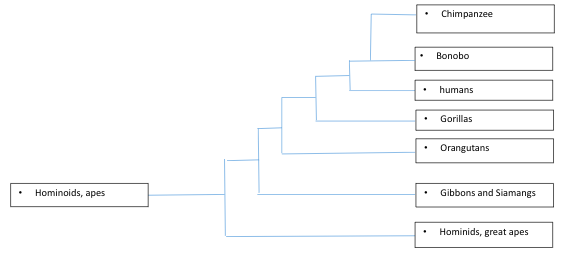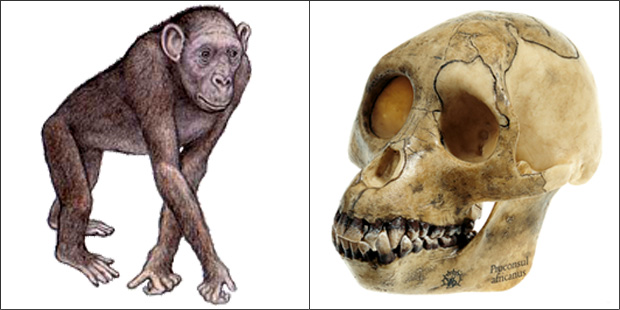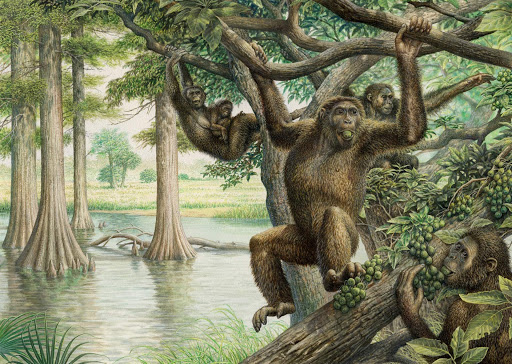Binomial Nomenclature of Modern-day Chimpanzee
In this paper, the organism of focus will be the Modern-day Chimpanzee. It is also referred to as chimp, robust chimpanzee, or common chimpanzee.
Chimpanzees are of the species great apes native to the savannah and forests in Africa. There are four main subspecies: the western, central, eastern, and Nigeria-Cameroon chimpanzee.
The fifth proposed subspecies is the southeastern chimpanzee.
They belong to the kingdom Animalia, phylum Chordata, subphylum Vertebrata, class Mammalia, order Primates, family Hominidae, genus Pan, and species group troglodytes.
Therefore, their scientific name is Pan troglodytes.
The Cladogram

The cladogram above shows the evolution of chimpanzees.
The earliest ancestor of modern-day chimpanzees is the hominoids or apes.
The hominoids’ fossil records date back to 18-25 million years ago (Henrich, 2018).
Through evolution, the present-day chimpanzees are the closest known relatives of human beings. Human beings split with chimpanzees five million years ago. There is fossil evidence of the existence of both chimpanzees and people during the Middle Pleistocene Period.
Later on, bonobos and chimpanzees split. This occurred less than one million years ago.
Picture of Chimpanzee and Its Ancestor


On the top, there is a picture of the chimpanzee, with its body covered with coarse hairs, except for the face, palms, and toes.
On the bottom is a drawing of the common ancestor, Proconsul Africanus.
Modern Chimpanzee Environment
Chimpanzees have higher adaptability; hence they have the widest range of habitats. According to National Geographic (n.d.), they are mainly found in the Central and Western parts of Africa.
Most Chimpanzees occupy the tropical rainforests, which include the evergreen rainforest, swamp forest, and semideciduous forests.
However, some of them can be found in the woodlands and grasslands that span West and Central Africa.
They usually sleep on trees where they use leaves to build themselves nests of a height of 7.90 meters every night in new locations (Badji et al., 2017).
Each chimpanzee has its own nest except for the infants, which spend the night with their mothers.
Chimpanzees prefer eating fruits besides other foods. However, they also feed on leaves, leaf buds, stems, seeds, barks, piths, and resin.
Ancestor Environment

The primitive hominoids such as Proconsul Africanus occupied a wide range of environmental niches. These varied from dense rainforests to open deciduous woodlands (Andrew, 2020). Some apes preferred to partially stay on the ground for some time.
The environment was generally referred to as a mosaic environment. The term mosaic refers to the heterogeneity of habitat, and it is thought to have occurred in the Plio-Pleistocene of South Africa and Kenya. However, there were variations between the two places.
The image above represents the hominoids in their natural environment (Ward et al., 2019).
Environmental Comparison/ Contrast
In both cases, their main environment is in Africa. According to Starr (2019), the modern chimpanzees are located in Central and West Africa.
However, the ancestors were located in the Mosaic environment in Kenya and South Africa (Parravicini & Pievani, 2019).
They both have a wide range of habitats, and some of them occupy the open woodlands.
The modern chimpanzees mainly prefer the tropical rainforests, while their ancestors lived in dense forests.
Traits of a Chimpanzee
According to National Geographic (n.d.), chimpanzees have an average lifespan of 45 years and a height of about four to five feet.
The adults have an average weight of between 70 and 130 pounds (National Geographic, n.d.)
Their bodies are mainly covered with coarse hair except on the faces, toes, fingers, and palms.
As the animals’ age, they start developing grey and white patches of hair, mainly on the chin.
Their heads are rounded, with a prognathous face and a prominent brow ridge. They have a small nose, eyes that face forward, the ears are round and non-lobed, and their upper lips are long and mobile.
They have a long pelvis with extended ileum.
With opposable toes, chimpanzees have adapted to terrestrial and arboreal movements. When on the ground, their movements are either bi- or quadrupedal.
According to Wallace et al. (2020), they have a pronounced curvature on foot and hand phalangeal as those of humans. These developments are a result of mechanical loads when the chimpanzees are grasping, hanging, and swinging from one branch to another.
Traits of Ancestor
During the middle of the Miocene period, the ancestors had a monkey as a body plan (Andrew, 2020). Moreover, their posture was also associated with the environment they lived in. However, towards the end of this period, some apes emerged with a broadened shoulder, scapula repositioned to the back of the top, long clavicles, and they had an upright posture.
The crown hominoids had enhanced limb motility and grasping ability, with long and opposable thumbs and curved phalanges.
Their skull was lightly built, and it lacked brow ridges (Andrew, 2020). They also had a broad incisive canal which provided a connected the oral cavity and nasal passages.
According to Andrew (2020), the ancestors had enlarged dentitions; the incisors were large, broad, and spatulate. Moreover, their canines were highly crowned and projected.
Their molars had a reduced molar cingulum.
Comparison of Traits
Both the chimpanzee and its ancestor have opposable toes. However, the phalanges in the former are curved as such of those of humans, while in the latter, they are long and curved.
Chimpanzees have long and pointed canines, while in the hominoids, they are highly crowned.
In both cases, there are quadrupedal movements. Nevertheless, modern chimpanzees also have bipedal locomotion.
Fun Facts
According to Voinov et al. (2020), amongst chimpanzees, facial expressions are key in their communications. For instance, a full-closed grin implies they are frightened. An open-mouthed grin shows they are happy and playful.
Amongst adults, the most common vocalization is the pant-hoot, and it signifies bonding and social ranks (Voinov et al., 2020).
Chimpanzees go hunting when the forest canopy is irregular or interrupted. They hunt in coordinated teams and mainly go after small monkeys like red Columbus.
There is a concept that DNA similarity between humans and chimpanzees is about 98%. However, it has been proved that the DNA similarity is around 84% (Tomkins, 2018).
The oldest known chimpanzee was called Little Mama, and she lived from around 68 to 72 years old, and she died in 2017 (Goodall, 2017).
References
Andrews, P. (2020). Last common ancestor of apes and humans: Morphology and environment. Folia Primatologica, 91(2), 122-148.
Badji, L., Ndiaye, P. I., Lindshield, S. M., Ba, C. T., & Pruetz, J. D. (2018). Savanna chimpanzee (Pan troglodytes verus) nesting ecology at Bagnomba (Kedougou, Senegal). Primates, 59(3), 235-241.
Goodall, J. (2017). Sad loss of Little Mama, one of the oldest chimps. Jane Goodall Institute.
Henrich, J., & Tennie, C. (2018). 18. Cultural Evolution in Chimpanzees and Humans. In Chimpanzees and human evolution (pp. 645-702). Harvard University Press.
History Files. (n.d.). Priminitive hominoids.
National Geographic. (n.d.). Chimpanzee. National Geographic.
Starr, E. (2019). Central chimpanzee: Pan troglodytes troglodytes. New England Primate Conservancy.
Parravicini, A., & Pievani, T. (2019). Mosaic evolution in hominin phylogeny: meanings, implications, and explanations. Journal of Anthropological Sciences, 97, 1-24.
Tomkins, J. (2018). Comparison of 18,000 De Novo assembled chimpanzee contigs to the human genome yields average BLASTN alignment identities of 84%. Answers Research Journal, 11, 215-219.
Voinov, P. V., Call, J., Knoblich, G., Oshkina, M., & Allritz, M. (2020). Chimpanzee coordination and potential communication in a two-touchscreen turn-taking Game. Scientific reports, 10(1), 1-13.
Wallace, I. J., Burgess, M. L., & Patel, B. A. (2020). Phalangeal curvature in a chimpanzee raised like a human: Implications for inferring arboreality in fossil hominins. Proceedings of the National Academy of Sciences, 117(21), 11223-11225.
Ward, C. V., Hammond, A. S., Plavcan, J. M., & Begun, D. R. (2019). A late Miocene hominid partial pelvis from Hungary. Journal of human evolution, 136, 102645.